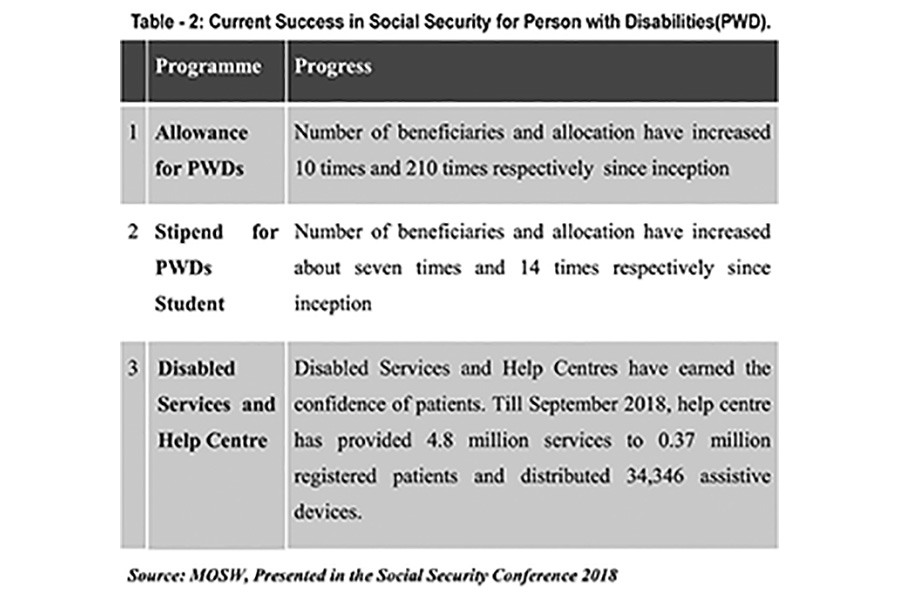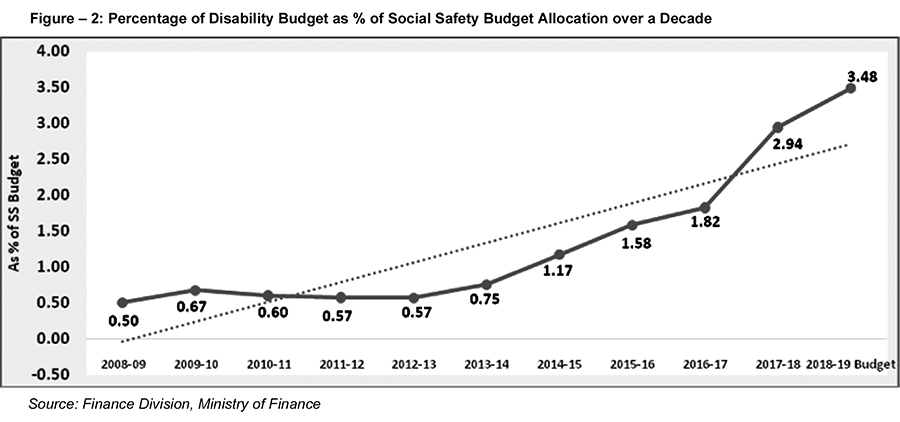December 3 was celebrated globally as the International Day of Persons with Disabilities (IDPD). Originally, annual observance of the IDPD was proclaimed for the first time in 1992, through a resolution by the United Nations General Assembly. The day has been observed over the years to improve the lives of disabled people around the globe and prevent disabilities in the first place. The aim of IDPD is to encourage a better understanding of people affected by a disability through the process of raising awareness of rights, dignity and welfare of people with disabilities. The 2018 UN theme for IDPD was "empowering persons with disabilities and ensuring inclusiveness and equality."
Bangladesh has recently become eligible for graduation from the category of Least Developed Country (LDC). As part of its progress, the country has prioritised "disability" as one of the major thematic areas of its development agenda. However, the overall situation of persons with disabilities is still far from satisfactory in the country. In fact, they are yet to be granted even low priority in service provisions. This is going to be an issue that Bangladesh would need to address fast. Inclusiveness is the key to realising the 2030 Agenda for Sustainable Development. Member States have already recognised that the dignity of the individual is fundamental and that the Agenda's goals and targets should be met for all nations and people and for all segments of the society. In this regard, the most important target for disabled people is SDG 8, which wants to "ensure decent work and economic growth for all'.
About 15 per cent of the world's population live with some form of disability, according to the World Health Organisation (WHO). The government of Bangladesh has recently reported that 0.91-9.17 per cent of Bangladesh's population suffer from one or another form of disability.
Significant strides were made over the past few years to address the situation of disabled population in the country. The Ministry of Social Welfare, in association with the National Forum of Organisations Working with the Disabled (NFOWD), had initiated the draft legislation on disability related issues in 1996. This legislation was formally enacted in April 2001 as The Disability Welfare Act of 2001. Later, the seminal Neuro-developmental Disability Protection Trust Act was followed by Person with Disabilities Rights and Protection Act 2013 passed in 2013.
Related surveys and studies in recent times have revealed some interesting points that can be of use to policy-makers.
In the Household Income & Expenditure Survey (HIES) of 2016, it was observed that people with some disabilities, severe disabilities and those fully bed-ridden are more in rural areas than urban areas. Disability does not just affect the individual but also the family and community. It becomes a poverty trap as disability and poverty are intertwined. While disability causes poverty, in a country with mass poverty it is also possible that poverty causes disability (Rao 1990). The underlying conditions behind this are poor nutrition, disabling diseases, inadequate access to preventative and curative healthcare, and an enhanced risk of occupation-related accidents among the poor.
According to the World Bank, it has been estimated that 15-20 per cent of the poor in developing countries are disabled. The necessity to bring about changes in order to mainstream disability into development efforts is also a result of studies indicating the multiple links between poverty and disability.

The Bangladesh government has committed to incorporate and add disability themes in various policies. In the National Social Security Bangladesh (NSSS), and the recently published NSSS Action Plan, the government has put emphasis on this particular sector. Over the next year, the Ministry of Social Welfare has decided to consolidate support to people with disabilities aligning it with the life course (as shown in Figure - 1).
The NSSS will involve three core schemes. These are:
- CHILD DISABILITY BENEFIT FOR ALL CHILDREN WITH A DISABILITY, TILL 18 YEARS OF AGE: Given the priority attached to children with disabilities, the amount may vary based on the severity of the disabled and associated cost for care. Certain mechanisms will be instrumental in removing children with disabilities from the streets in order to prevent exploitation.
- DISABILITY BENEFIT FOR ALL ADULTS WITH SEVERE DISABILITIES, AGED 19-59 YEARS: This particular scheme will mark a significant change in the lives of the disabled citizens by giving them a moral boost. Through the benefit, they will be able to enter the labour market and access credit that they can invest in small businesses.
- AT 60 YEARS, PEOPLE WITH SEVERE DISABILITIES WILL TRANSITION TO THE OLD AGE ALLOWANCE: The ministry of social welfare will define the disability and income criterion for inclusion into this programme.
In Figure -2, it can be observed that the disability budget, as a percentage of social safety (SS) budget, has been experiencing a hike over the last 10 years. The percentage share was constant from 2009 to 2013 and starting from 2014-15, there has been an increase in disability budget standing at 3.49 per cent of SS budget in 2018-19. This indicates that the government has an inclusive budget in mind. The budget has increased allocations for cash transfer and in-kind services for persons with disabilities under social protection and social empowerment schemes. At present, more than one million people with disabilities are covered under the disability social security schemes. The government currently has 12 disability-related projects under the Social Protection schemes.
While the 7th Five Year Plan (FYP) stipulates an average yearly rapid economic growth of 7.4 per cent, complimentary strategies and polices are in place to ensure that this growth is inclusive and sustainable. In the 7th FYP, it is mentioned that the goal is to involve local communities, particularly women, children and persons with disabilities, in decision-making and at setting priorities for the provision of services. It, therefore, encapsulates a strategy that empowers individuals by creating opportunities so that people can be more productive. Experience suggests that in the long term, a strategy of inclusiveness enhances growth.
The Social Security Action plan has suggested mainstreaming of the existing social security programmes to include disabled people. In order to design a detailed and preventive social security scheme for the disabled population, the first step would be to collect detailed data on them. These will include aspects such as parents with disabled children living below poverty line, qualified unemployed disabled persons who can be employed, severely disabled persons who require constant support, disabled people above 60 years of age, disabled people working in the informal sector, etc. Government and non-governmental organisations (NGOs) have already started working on the project to identify people with disabilities. It will introduce new mapping and training which can also improve the vulnerable situation and capacity of the people with disabilities.
It is evident (from Table 2) that the major programmes have been successful in implementing the social security programmes, with allocations and beneficiaries growing. The disability grant for financially insolvent persons with disabilities provides Tk 600 per month which is equivalent of 5.5 per cent of GDP per capita. In comparison, Nepal provides 22 per cent of GDP per capita and South Africa 28 per cent to people in similar categories. This indicates that Bangladesh Disability Grant is still very low even by developing country standards.
The government has been trying to open up job market for the disabled people. It must be kept in mind that creating job opportunities for People with Disabilities (PWDs) is not charity. It is the constitutional right of every PWD to have a decent job.
A disability job fair was held on November 14-15 in Dhaka by the National Foundation for Development of Disabled People. The main objective was to generate employment for PWDs and to bring all the pro-disability entrepreneurs to a single platform where they shared knowledge, good practices and success stories and thus inspired others to make their organisations disability-inclusive. In the network, there were also members from Disabled People's Organisations (DPOs) and NGOs who are working on disability. This was a good example of collaboration between the supply and demand sides. The details of profiling and matching competencies of the PWDs were done so that prospective employers can easily find suitable candidates. After the successful Dhaka job fair, there are plans to reach out to Chattogram, Sylhet and other areas of the country.

The government has a national human resource development fund. A segment of the fund will go to organisations that are working on disability issues.
In the Income Tax Ordinance, the concept of PWDs has been legally incorporated. They do not need to pay taxes up to income of Tk 400,000.
Corporate organisations can allow expenses up to Tk. 1 million for their employees with disabilities. Generally, the limit of allowable expense for the average employee is Tk 475,000. Again corporate organisations can spend up to Tk 2.5 million as medical allowances for employees with disabilities without paying taxes. These benefits are in alignment with the constitutional pledge of the country. For industries, the investment they make for PWDs is considered as corporate social responsibility (CSR), which is tax-free. If they establish a separate entity for PWDs, the whole expenditure of that institution will be exempted from tax.
Every year, before the budget, NBR holds discussions with stakeholders where they can all participate and make suggestions for making our tax structure more disabled-friendly. Big NGOs dealing with disability programmes should also be consulted along with stakeholders before making the annual budget.
Till today, the transport system of the country is not disabled-friendly. For disabled school-going children and to support the disabled workforce, it is an important pre-condition to have accessible footpaths, transport and buildings. In order to have a more inclusive environment, importance should be placed on more accessible venues, facilitate active and accommodative participation during meeting and events and use inclusive and respectful language and images.
Among the 17 SDGs, 13 are related to disability issues. So, to achieve SDG targets, the nation needs to bring PWDs to the mainstream and facilitate their access to education and jobs. It should be a continuing priority for the government, civil society and other stakeholders to have an inclusive approach to ensuring national productivity. The policies, funds, institutions and congenial policy environment required to materialise this dream is already in place. Strategic measures by government with cooperation from all stakeholders could turn this into a reality.
Dr Shamsul Alam is Member (Senior Secretary), General Economics Division, Planning Commission.